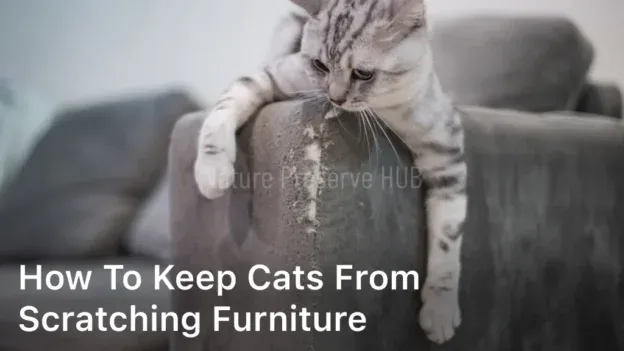Naturepreservehub.com. Effective Tips on How to Keep Cats from Scratching Furniture – Discover how to keep cats from scratching furniture with our effective tips. Save your favorite furniture pieces from those stubborn claws today! As cat owners, we love our feline friends, but we don’t always love the damage they can cause to our furniture with their scratching. Luckily, there are effective tips and techniques to prevent cats from scratching our beloved furniture. In this section, we will explore practical solutions to help save our furniture from those stubborn claws once and for all. Key Takeaways: Understanding why cats scratch furniture can help us find better alternatives for them to scratch. Providing suitable scratching surfaces, such as scratching posts, pads, and boards, is an effective way to deter cats from scratching furniture. Using deterrents and training techniques, such as repellents and positive reinforcement, can help discourage cats from scratching furniture. Patience and consistency are key to preventing cats from scratching furniture and creating a harmonious environment for both cat and furniture. Understanding Why Cats Scratch Furniture As cat lovers, we all know that cats love to scratch. But what is it about our furniture that makes it so irresistible to them? Understanding the reason behind this behavior is the first step in finding a solution. Instinctual Behavior Firstly, it’s important to note that scratching is a natural and instinctual behavior for cats. Scratching helps them relieve stress, mark their territory, and maintain their claws. In the wild, cats scratch trees and other rough surfaces to keep their claws sharp and healthy. Texture and Scent When it comes to furniture, cats are drawn to certain textures and scents. They prefer rough, textured surfaces that allow them to really sink their claws into. Additionally, cats have scent glands in their paws, so when they scratch, they’re also marking the furniture with their scent. Boredom and Anxiety Cats may also scratch furniture out of boredom, anxiety, or frustration. If they’re not getting enough mental or physical stimulation, they may resort to destructive behaviors like scratching. Similarly, if they’re feeling stressed or anxious, they may turn to scratching as a release. Providing Suitable Scratching Surfaces As we learned earlier, cats have a natural instinct to scratch. Providing them with suitable scratching surfaces is crucial in preventing them from scratching your furniture. Here are some tips on how to choose the right scratching surface: Type of Scratching Surface Pros Cons Scratching Posts Tall, sturdy posts provide vertical scratching option Can be covered in various materials like sisal, carpet, or cardboard May take up space in the room May not fit your home decor style Scratching Pads Small, portable surface Can be made of various materials like cardboard, sisal, or carpet Can be placed near furniture to redirect cat’s attention May not provide vertical scratching option May not be as durable as posts Scratching Boards Flat surface that can be hung or placed on the floor Can be covered in various materials like sisal or corrugated cardboard May not provide vertical scratching option May not be as durable as posts Once you have chosen the right scratching surface, it’s important to encourage your cat to use it. Here are some tips: Place the scratching surface near your cat’s favorite furniture. Rub catnip on the scratching surface to attract your cat. Praise your cat when they use the scratching surface. Redirect your cat’s attention to the scratching surface when you catch them scratching furniture. Consider having multiple scratching surfaces available in different rooms. By providing suitable scratching surfaces and encouraging your cat to use them, you can save your furniture from their sharp claws. Using Deterrents and Training Techniques Providing suitable scratching surfaces is often effective, but some cats may still target your furniture. If this is the case, it’s time to use deterrents and training techniques. Using Repellents Repellents work by creating an unpleasant sensation or smell that cats dislike, making them less likely to scratch. There are various commercial cat repellent sprays available, or you can create your own natural deterrents using citrus fruits or essential oils. However, it’s crucial to ensure that the repellent is safe for your cat and won’t damage your furniture. Test a small area first and observe your cat’s reaction. Positive Reinforcement Positive reinforcement involves rewarding your cat for desirable behaviors, such as using a scratching post. Whenever you see your cat using the scratching post, offer praise, petting, or treats. This method reinforces the idea that scratching the post is a desirable behavior and encourages your cat to continue doing it. Redirecting Behavior If your cat continues to scratch furniture, try redirecting their behavior to a more suitable surface. Use toys, treats, or catnip to encourage them to approach the scratching post. Place the post near the furniture they tend to scratch, and gradually move it to a more suitable location. Reinforce positive behavior with treats or praise. Deterrents and Training Techniques Pros Cons Repellents Can be effective in preventing scratching May not work for all cats; some commercial repellents may have harmful chemicals Positive Reinforcement Reinforces desirable behavior and strengthens bond with your cat May take time and patience to see results; may not work for all cats Redirecting Behavior Encourages your cat to use a suitable scratching surface May take time and patience to see results; may not work for all cats There are various methods you can use to prevent your cat from scratching furniture. It’s essential to find a solution that works for your cat’s individual personality and behavior. With patience and consistency, you can successfully train your cat to use suitable scratching surfaces and save your furniture from damage. Conclusion Keeping cats from scratching furniture can be a cause of frustration for many cat owners. However, by implementing the tips and techniques we have discussed, you can successfully prevent your cats from scratching your beloved furniture. It’s important to understand that scratching is a natural behavior for cats and providing them with suitable





